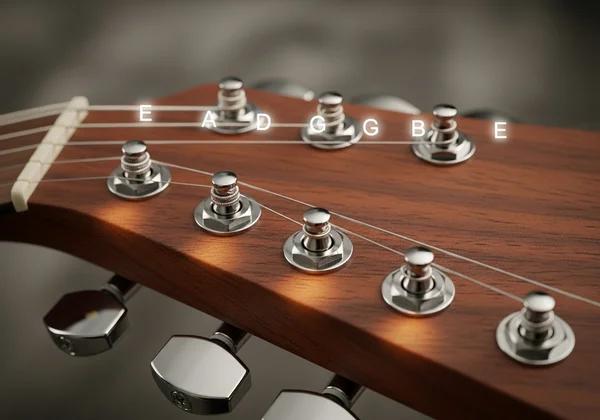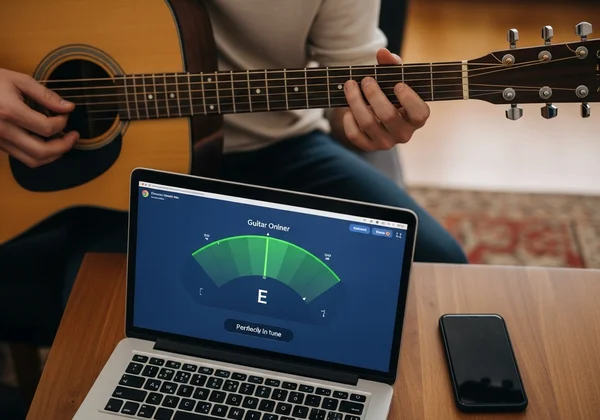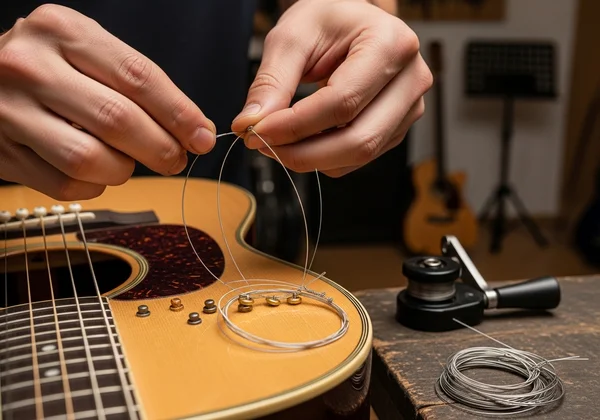The Ultimate Guide to Guitar Tuning: Your Free Online Tuner for Any Guitar
There's no sound more frustrating to a musician than an out-of-tune guitar. It can make beautiful chords sound jarring and simple melodies feel wrong. Proper guitar tuning is the foundation of great sound, whether you're practicing in your room, recording a track, or performing on stage. But for many, the question remains: how to tune a guitar? This guide will walk you through everything you need to know, from the basic principles to advanced techniques, all while showing you how a simple online tool can be your most reliable partner.
Whether you're a complete beginner or a seasoned pro, achieving perfect pitch is now easier than ever. With a high-quality free online tuner, you can get your instrument ready to play in seconds. Let's dive into the art and science of getting your guitar perfectly in tune.
Understanding Guitar Tuning Basics: Why & How to Tune Your Instrument
Before you can tune your guitar, it helps to understand what you're actually doing. Tuning is the process of adjusting the tension of your strings to make them produce specific pitches. When all strings are set to the correct pitch, they create harmonious sounds when played together. This section covers the fundamental concepts every guitarist should know.
The Science of Sound: Pitch, Frequency, and Your Guitar Strings
Every sound you hear is a vibration, and the speed of that vibration is called frequency, measured in Hertz (Hz). Higher frequency means a higher pitch. When you play a guitar string, it vibrates at a specific frequency. Turning the tuning peg on your guitar's headstock either tightens or loosens the string, which changes its vibrational frequency and, therefore, its pitch. A tuner's job is to measure this frequency and tell you if it's correct.
Standard Tuning Explained (E-A-D-G-B-e)
The most common tuning for a six-string guitar is called "Standard Tuning." The strings are tuned to the following notes, from the thickest (lowest pitch) to the thinnest (highest pitch):
- 6th String (thickest): E
- 5th String: A
- 4th String: D
- 3rd String: G
- 2nd String: B
- 1st String (thinnest): e (two octaves higher than the 6th string)
This E-A-D-G-B-e configuration is the basis for most chords and scales you'll learn. Mastering standard tuning is the essential first step for any guitarist.

Different Methods to Tune Your Guitar: Which is Best for You?
There are several ways to tune a guitar. Some musicians use a reference pitch from a piano or tuning fork to tune by ear, a skill that takes years to develop. Others use physical clip-on tuners or pedal tuners, which are great but can be expensive or get misplaced. In the digital age, tuner apps and online tools have become the most convenient and accurate option for millions of musicians. An online instrument tuner combines accuracy with unparalleled ease of use.
Using an Online Guitar Tuner: Your Go-To Guide for Accuracy & Convenience
An online tuner uses your device's microphone to listen to the note you're playing and gives you instant visual feedback. This method is fast, precise, and completely free. It’s the perfect solution for beginners who need clear guidance and for gigging musicians who need a quick backup tuner.
Step-by-Step Guide: How to Tune Your Guitar Online with Our Online Tuner
Using an online tuner is incredibly simple. Here’s how you can get your guitar in perfect tune right now using the tool on our homepage:
-
Visit the Website: Open our online tuner on your computer, tablet, or smartphone.
-
Allow Microphone Access: Your browser will ask for permission to use your microphone. Click "Allow" so the tuner can hear your guitar.
-
Pluck a String: Start with the thickest string (the low E). Pluck it clearly and let the note ring out.
-
Read the Feedback: The tuner will display the note it detects. A needle or indicator will show if the note is "flat" (too low) or "sharp" (too high).
-
Adjust the Tuning Peg:
- If the note is flat, slowly tighten the string by turning the corresponding tuning peg.
- If the note is sharp, slowly loosen the string.
-
Repeat Until Perfect: Keep plucking and adjusting until the tuner indicates the note is perfectly in tune. Repeat this process for all six strings (E-A-D-G-B-e).

Microphone Tuner Tips: Maximizing Accuracy for Every Note
To get the best results from a microphone-based tuner, follow these simple tips:
- Find a Quiet Space: Tune in a room with minimal background noise so the microphone only picks up your instrument.
- Pluck One String at a Time: Mute the other strings with your hand to ensure the tuner hears only the note you intend to tune.
- Be Gentle but Firm: Pluck the string with a consistent, moderate attack. Plucking too hard can temporarily make the note sharp.
- Place Your Device Close: Position your phone or laptop's microphone near your guitar's soundhole or body for a clear signal.
Following these tips helps our accurate tuner give you the most precise reading possible.
When to Tune: Before Practice, During Gigs, and Beyond
How often should you tune? The short answer is: often. Guitars are sensitive to changes in temperature and humidity, and strings naturally lose tension as you play. For best tuning stability, make it a habit to tune your guitar every single time you pick it up to play. It's also wise to check your tuning between songs during a long practice session or a live performance.
Exploring Alternate Guitar Tunings: Unlock New Sounds & Styles
While standard tuning is essential, countless artists use alternate tunings to create unique sounds and make certain chord shapes easier to play. An online chromatic tuner is the perfect tool for exploring these new sonic landscapes because it detects any of the 12 musical notes, not just the standard E-A-D-G-B-e.
Popular Alternate Tunings: Drop D Tuning, Open G, DADGAD & More
Many genres, from metal and rock to folk and blues, rely on alternate tunings. Here are a few popular examples you can easily achieve:
-
Drop D: Simply lower your 6th string from E down to D. This creates a powerful, heavy sound used in countless rock songs.
-
Open G: Tuned D-G-D-G-B-D. Strumming the open strings produces a G major chord, famous in blues and slide guitar.
-
DADGAD: A favorite in folk and Celtic music, this tuning creates a beautiful, resonant, and somewhat mysterious sound.

How to Use a Chromatic Tuner for Any Custom Tuning
The beauty of our chromatic tuner is its chromatic capability. To achieve any alternate tuning, simply pluck the string you want to change and adjust the tuning peg until the display shows the target note you're aiming for. It doesn't matter if it's a standard note or not—our chromatic tuner will guide you there with precision.
Beyond Basic Tuning: String Changes, Intonation & Troubleshooting
Keeping your guitar in tune involves more than just turning the pegs. Proper instrument maintenance plays a crucial role in how well your guitar holds its pitch. Here are some key areas to consider for long-term tuning stability.
Changing Your Guitar Strings: A Fresh Start for Better Tone & Tuning
Old, worn-out strings can't hold their tuning properly and sound dull. Changing your strings regularly (every 1-3 months for an average player) is one of the best things you can do for your guitar's tone and tuning stability. Fresh strings are brighter, clearer, and more reliable. When you're done restringing, our guitar tuner tool will help you get them up to pitch perfectly.

Introduction to Guitar Intonation: Why Your Guitar Might Still Sound Off
Have you ever tuned your open strings perfectly, only to find that the chords you play higher up the neck sound out of tune? This is likely an intonation problem. Intonation refers to the accuracy of the notes across the entire fretboard. While adjusting it is a more advanced task for a guitar technician, recognizing the issue is the first step. If your guitar is properly tuned but sounds off, it might be time for a professional setup.
Common Tuning Problems & Quick Fixes
If you find your guitar constantly going out of tune, here are a few common culprits:
- Slipping Tuning Pegs: The gears inside your tuners can wear out. If a peg feels loose, it may need tightening or replacement.
- Improperly Wound Strings: Make sure you have several clean wraps around the tuning post when changing strings.
- Nut Issues: The string can sometimes get stuck in the nut (the small white or black piece at the top of the fretboard), causing tuning "jumps."
Master Your Pitch: Confident Tuning for Every Performance
Tuning your guitar is the most fundamental skill a player can have. It's the bridge between silence and music, and it ensures that the effort you put into practicing translates into beautiful sound. From understanding the basics of pitch to exploring creative alternate tunings, the key is having a reliable and accurate tool at your disposal.
This platform was built to be that tool—a free, convenient, and precise online tuner for every musician. There's nothing to download and no ads to distract you. It's just a pure, simple tool to help you sound your best. Start tuning now and play with the confidence that comes from perfect pitch.
Frequently Asked Questions About Guitar Tuning
Is an online guitar tuner accurate enough for professional use?
Absolutely. Modern online tuners use sophisticated algorithms to detect frequencies with a high degree of precision, rivaling that of professional physical tuners. They are more than accurate enough for practicing, recording, and even live performances, especially as a reliable and instantly accessible option.
What is standard guitar tuning and why is it important?
Standard guitar tuning refers to the notes E-A-D-G-B-e, from the lowest string to the highest. It's the most widely used tuning because its note intervals make it versatile for playing the widest variety of chords and scales across all genres of music. Learning it is the foundation for almost all guitar education.
Can I use my phone's microphone to tune my guitar with our online tuner?
Yes! Our online tuner is designed to work seamlessly on any device with a web browser and a microphone, including smartphones, tablets, and laptops. Simply visit the homepage on your phone, grant microphone access, and you can tune your guitar anywhere, anytime.
How often should I tune my guitar?
It's best practice to tune your guitar every time you pick it up to play. Strings are affected by changes in temperature, humidity, and the tension of playing. A quick tune-up before you start ensures you are always practicing and performing with the correct pitch.
What's the difference between a standard tuner and a chromatic tuner?
A standard guitar tuner is typically programmed to recognize only the six notes of standard tuning (E, A, D, G, B, e). A chromatic tuner, on the other hand, can detect all 12 musical pitches in the Western scale. This makes a chromatic tuner far more versatile, allowing you to tune to any alternate tuning you desire.